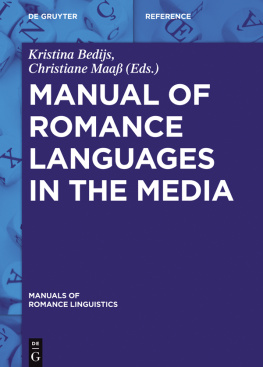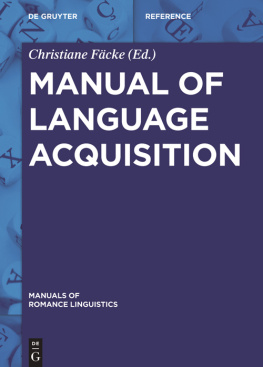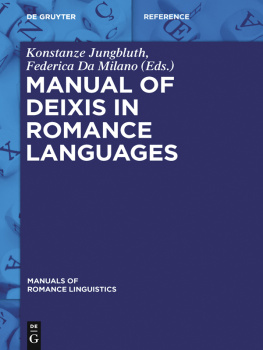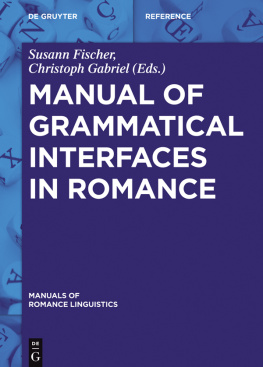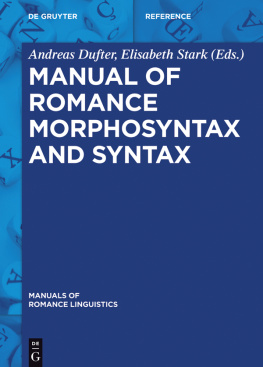Table of Contents
Guide

Manual of Romance Languages in the Media
MRL 23
Manuals of
Romance Linguistics
Manuels de linguistique romane
Manuali di linguistica romanza
Manuales de lingstica romnica

Edited by
Gnter Holtus and Fernando Snchez Miret
Volume 23

ISBN 978-3-11-031471-7
e-ISBN (PDF) 978-3-11-031475-5
e-ISBN (EPUB) 978-3-11-039521-1
Library of Congress Cataloging-in-Publication Data
A CIP catalog record for this book has been applied for at the Library of Congress.
Bibliographic information published by the Deutsche Nationalbibliothek
The Deutsche Nationalbibliothek lists this publication in the Deutsche Nationalbibliografie; detailed bibliographic data are available on the Internet at: http://dnb.dnb.de.
2017 Walter de Gruyter GmbH, Berlin/Boston
www.degruyter.com
Manuals of Romance Linguistics
The new international handbook series Manuals of Romance Linguistics ( MRL ) will offer an extensive, systematic and state-of-the-art overview of linguistic research in the entire field of present-day Romance Studies.
MRL aims to update and expand the contents of the two major reference works available to date: Lexikon der Romanistischen Linguistik ( LRL ) (19882005, vol. 18) and Romanische Sprachgeschichte ( RSG ) (20032008, vol. 13). It will also seek to integrate new research trends as well as topics that have not yet been explored systematically.
Given that a complete revision of LRL and RSG would not be feasible, at least not in a sensible timeframe, the MRL editors have opted for a modular approach that is much more flexible:
The series will include approximately 60 volumes (each comprised of approx. 400600 pages and 1530 chapters). Each volume will focus on the most central aspects of its topic in a clear and structured manner. As a series, the volumes will cover the entire field of present-day Romance Linguistics, but they can also be used individually. Given that the work on individual MRL volumes will be nowhere near as time-consuming as that on a major reference work in the style of LRL , it will be much easier to take into account even the most recent trends and developments in linguistic research.
MRL s languages of publication are French, Spanish, Italian, English and, in exceptional cases, Portuguese. Each volume will consistently be written in only one of these languages. In each case, the choice of language will depend on the specific topic. English will be used for topics that are of more general relevance beyond the field of Romance Studies (for example Manual of Language Acquisition or Manual of Romance Languages in the Media ).
The focus of each volume will be either (1) on one specific language or (2) on one specific research field. Concerning volumes of the first type, each of the Romance languages including Romance-based creoles will be discussed in a separate volume. A particularly strong focus will be placed on the smaller languages ( linguae minores ) that other reference works have not treated extensively. MRL will comprise volumes on Friulian, Corsican, Galician, Vulgar Latin, among others, as well as a Manual of Judaeo-Romance Linguistics and Philology .Volumes of the second type will be devoted to the systematic presentation of all traditional and new fields of Romance Linguistics, with the research methods of Romance Linguistics being discussed in a separate volume. Dynamic new research fields and trends will yet again be of particular interest, because although they have become increasingly important in both research and teaching, older reference works have not dealt with them at all or touched upon them only tangentially. MRL will feature volumes dedicated to research fields such as Grammatical Interfaces, Youth Language Research, Urban Varieties, Computational Linguistics, Neurolinguistics, Sign Languages or Forensic Linguistics. Each volume will offer a structured and informative, easy-to-read overview of the history of research as well as of recent research trends.
We are delighted that internationally-renowned colleagues from a variety of Romance-speaking countries and beyond have agreed to collaborate on this series and take on the editorship of individual MRL volumes. Thanks to the expertise of the volume editors responsible for the concept and structure of their volumes, as well as for the selection of suitable authors, MRL will not only summarize the current state of knowledge in Romance Linguistics, but will also present much new information and recent research results.
As a whole, the MRL series will present a panorama of the discipline that is both extensive and up-to-date, providing interesting and relevant information and useful orientation for every reader, with detailed coverage of specific topics as well as general overviews of present-day Romance Linguistics. We believe that the series will offer a fresh, innovative approach, suited to adequately map the constant advancement of our discipline.
Gnter Holtus (Lohra/Gttingen)
Fernando Snchez Miret (Salamanca)
July 2017
Media and Linguistics
Kristina Bedijs and Christiane Maa
0Preface
This manual in the series of Romance Linguistics is dedicated to the use of Romance languages in the media. It focuses on media linguistic research on Romance languages and media linguistic approaches from Romance countries and Romance studies. Today, media culture is clearly global, but media content is delivered in different (also Romance) languages and is part of language-bound discourses. Unlike in everyday language, where media usually means analog or digital messages, the term media in media and communication studies and linguistics is a rather broad one, and so is the term message. Media can mean the air carrying acoustic waves from a mouth to an ear; it can mean the wire between two landline telephones carrying electronic signals converted from speech; it can mean an application on a smartphone which displays text and pictures sent from another smartphone; it can mean a radio receiver.
No manual of linguistics can cover all media in the broadest sense of the term. Besides the fact that much research has been done on fundamental questions by media and communication studies, there has also been research from the linguistic perspective for decades. Nonetheless, the articles in this volume cite and reflect the most relevant publications in their respective fields. Print media have long been the basis of both communication studies and media linguistics, and investigations of the language in newspapers abound (cf., e. g., the volume edited by Dahmen et al. 2006 and the overview in Wilhelm 2006) not only because these media are the oldest, but also because they provided easy access for linguistic research even before the computer-assisted possibilities of analysis had emerged: text and visuals were directly available without technological aid. Such media are called secondary media in the terminology of Pross (1972): they require technical devices only on the senders side.
Prosss study, which became highly influential in German media studies, distinguishes between primary, secondary and tertiary media. In the case of primary media, no device is interposed between sender and recipient of a media text, and peoples senses are sufficient to produce, transport and consume the message (cf. Pross 1972, 145). Secondary media require technical devices for content production but not for content perception. Tertiary media depend on technical devices for content production and content perception. The distinction between primary, secondary and tertiary media according to the technical support needed to produce and to receive content is still the dominant classification in the German-speaking areas. Other classifications operate according to the sense of perception (visual, auditive, audiovisual) or according to the relationship between the sender and the addressed public.

